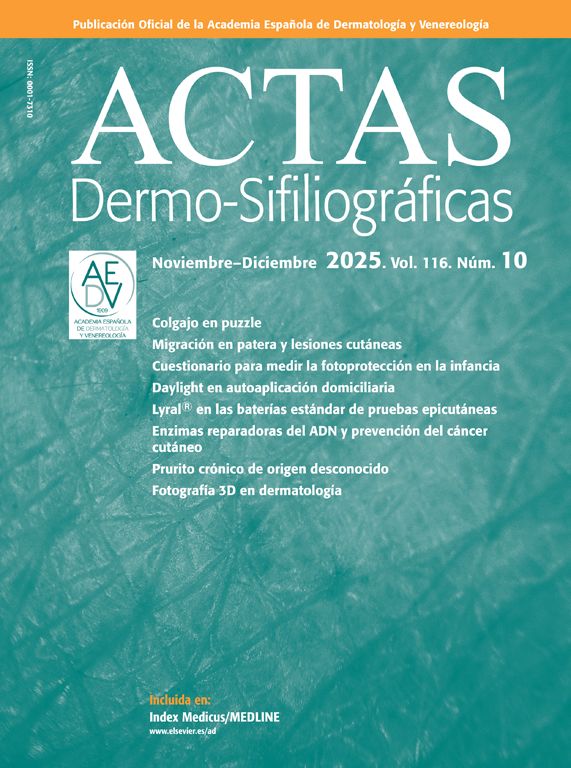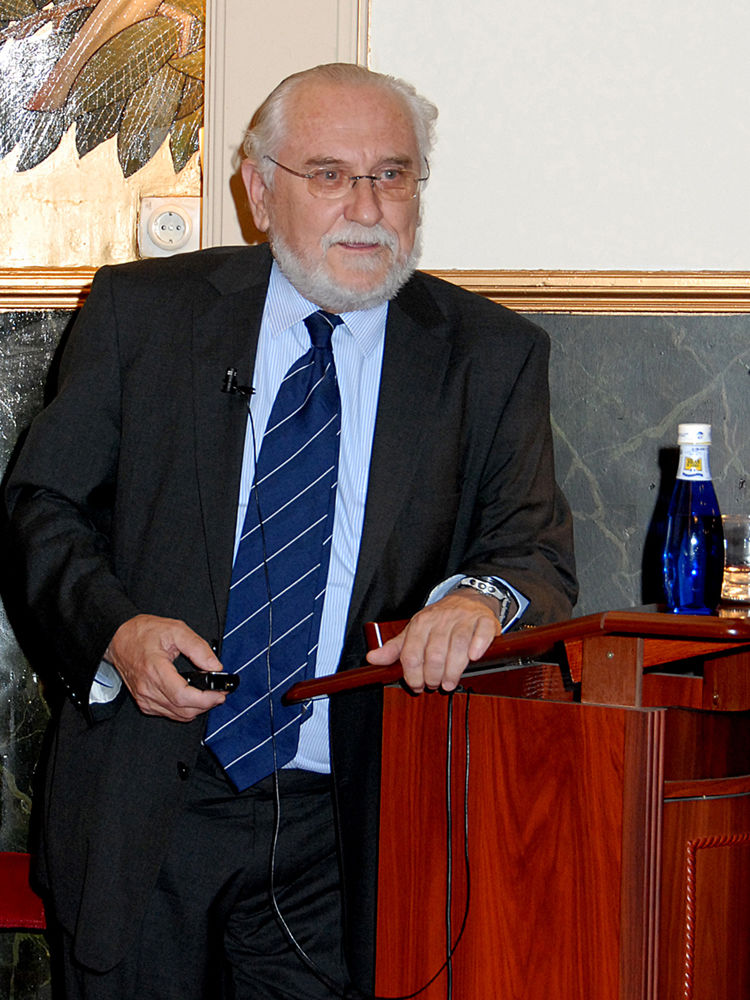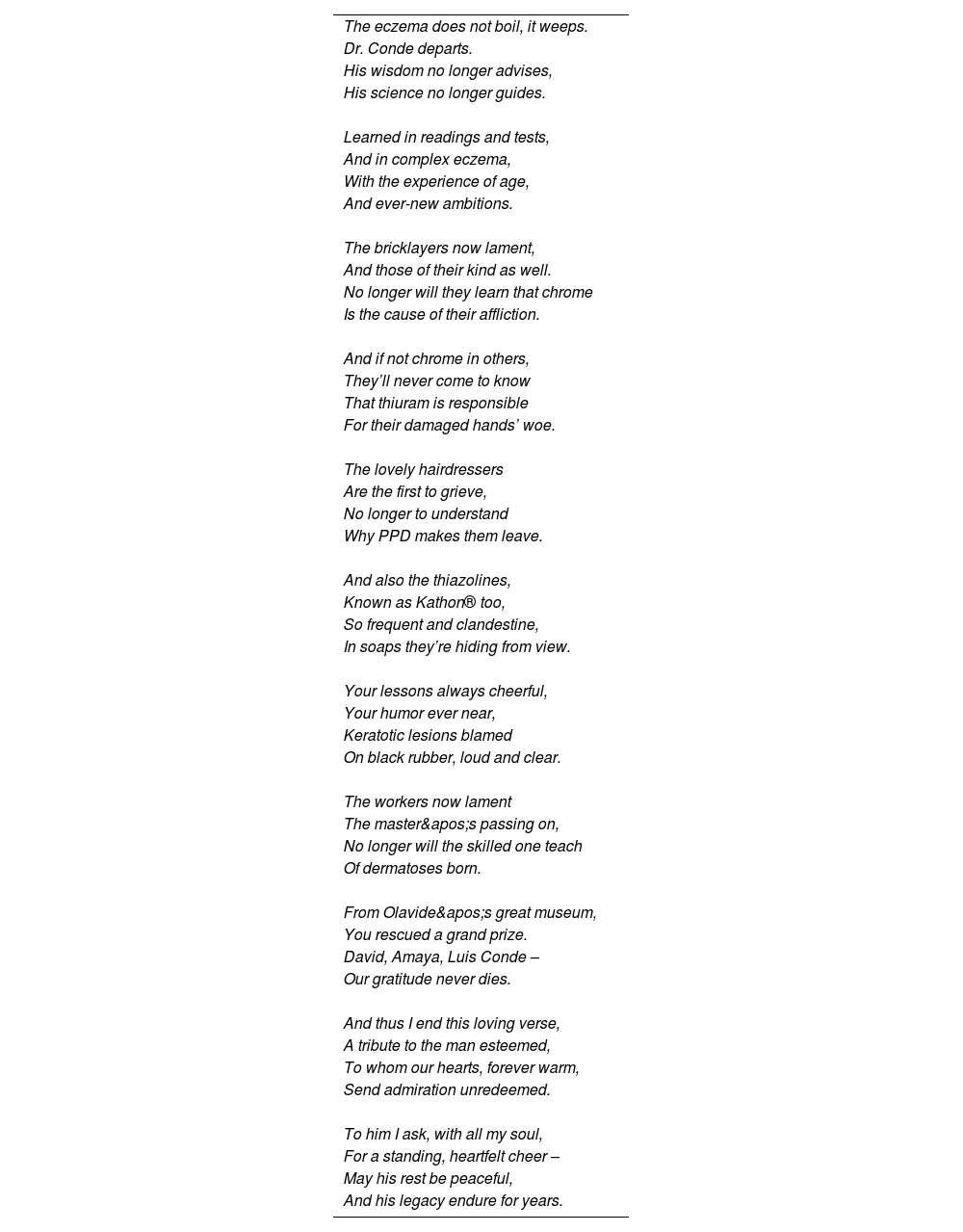On March 29th, Dr. Luis Conde-Salazar Gómez passed away in Madrid at the age of 81. A figure of immense importance in Spanish dermatology and with a wide international influence, he was a man of restless curiosity and many interests. Above all, he stood out for his dedication to dermatology and the extraordinary legacy he leaves in this field, which I would like to briefly summarize.
Dr. Conde devoted his career primarily to contact dermatology and occupational dermatoses. In fact, he was one of the founders, in 1976, of the Spanish Group for Research on Contact Dermatitis (GEIDC, now GEIDAC). Almost his entire professional life was spent in the now-defunct Occupational Dermatology Service of the National School of Occupational Medicine in Madrid. Over the years, numerous dermatologists (myself included) collaborated with him there, along with many residents in dermatology, allergology, and occupational medicine. It is difficult to find a specialist in these fields who does not know, or has never heard of, Dr. Conde.
His research and teaching output was vast. I will not attempt to list all of his scientific contributions here, but rather to highlight his tireless and inquisitive spirit that kept him constantly active. Whenever he finished writing a chapter for a book, he was already planning a new treatise on occupational dermatoses, a series of articles, or a training course. His scientific work never rested – not even after retirement.
Dr. Conde was a world authority in contact and occupational dermatology. He leaves behind countless friends in the United States, Europe, and especially Latin America, where several schools devoted to the study of eczema and occupational dermatoses emerged under the leadership of his disciples. It is therefore unsurprising that he was named an honorary member of several international dermatology societies and awarded the title of “Master of Ibero-Latin American Dermatology.”
Yet, perhaps his greatest legacy is found in his daily clinical practice, witnessed by those fortunate enough to observe it. Dr. Conde examined each patient surrounded by the physicians on duty, beside a large window that provided excellent lighting. As the resident carefully presented the patient's history, he would silently inspect the lesions. If the resident began to digress into irrelevant details, he would gently interrupt to ask the key questions himself – or he might turn to the other doctors, initiating a round of case questions that raised our stress levels but always inspired us to study harder.
His ability to extract meaningful details from a patient's history was extraordinary. He asked about aspects of work that most would overlook but which could prove crucial for understanding the condition. He often asked patients to demonstrate daily work movements or how they handled tools, so that their lesions could be better explained.
His detective work did not end there. Frequently, he visited the patient's workplace, taking extensive photographic documentation. Later, he would present these cases at meetings and conferences with engaging presentations – so captivating that the audience often found the occupational background even more fascinating than the dermatologic condition per se.
Dr. Conde often said that his dedication to occupational dermatoses allowed him to gain knowledge far beyond medicine – learning about types of cement, airplane manufacturing, or the industry behind cutting fluids. His curiosity about people's jobs, working conditions, salaries, and other non-medical aspects enriched his understanding of patients and their environments, offering a holistic perspective far beyond the clinical.
For many workers with contact allergies, there was a clear before and after in their lives following an evaluation in his department, since diagnosis often meant they could no longer continue in their profession. Conde approached these patients with empathy, explaining the process toward obtaining permanent disability benefits and encouraging them to find new careers free of the allergen in question. Particularly moving were the consultations with hairdressers allergic to paraphenylenediamine, who would burst into tears when told they could no longer work. Conde comforted them like a father, reassuring them that life would go on and that they would eventually find better health and opportunities.
He was demanding with his collaborators, insisting on punctuality, impeccable and structured case histories, and preparation for sessions, presentations, and publications. Yet, he was also joyful and known for his humor – even during the difficult final weeks of his illness.
Despite his rigor, he was compassionate toward everyone's personal circumstances. He cared deeply for foreign physicians training in Spain, often helping them find housing and supplemental income. In my own case, after my contract lapsed due to bureaucratic delays, I continued attending daily rounds without pay. Dr. Conde summoned me to his office and asked what my previous salary had been, intending to personally write me a check each month until my contract was renewed. Though I initially refused, his insistence left me no choice, and he paid me out of his own pocket until my position was restored.
In the past two decades, his passion turned toward the Olavide Museum, a unique collection of wax dermatological models. Thanks to his perseverance and the collaboration of restorers Amaya Maruri and David Aranda, this priceless collection was rescued. With Conde's leadership and determination, the Spanish Academy of Dermatology and Venereology (AEDV) supported its restoration and exhibition. It would take too long to recount the obstacles and setbacks he faced, but suffice it to say: without Dr. Conde, this remarkable legacy of dermatological history would have been lost forever.
He not only directed the restoration of the wax figures but also founded the “Professor García Pérez” Library, which houses numerous historic dermatology treatises, primarily obtained through donations from dermatologists and their families – volumes that Dr. Conde personally sought and curated over the years. This collection, housed within the Olavide Museum, was later enriched by materials from the former AEDV library, forming an invaluable bibliographic archive.
Dr. Conde also recovered and displayed historic dermatological instruments, charts, and photographs, transforming the Olavide Museum into a beautiful reflection of Spanish dermatological heritage.
His commitment to academia was profound. He served on the AEDV Board of Directors as treasurer in the early 1980s and continued collaborating with the Academy thereafter. He was responsible for locating and facilitating the purchase of the AEDV headquarters at Calle Ferraz 100, inaugurated in 1993. For this and much more, every dermatologist owes him gratitude for his lasting contributions.
No better conclusion could be found than the verses dedicated to him by Dr. Amaro García during an AEDV Central Section meeting in 2013, on the occasion of Dr. Conde's retirement – a moving and poetic summary of his professional life:
| The eczema does not boil, it weeps. |
| Dr. Conde departs. |
| His wisdom no longer advises, |
| His science no longer guides. |
| Learned in readings and tests, |
| And in complex eczema, |
| With the experience of age, |
| And ever-new ambitions. |
| The bricklayers now lament, |
| And those of their kind as well. |
| No longer will they learn that chrome |
| Is the cause of their affliction. |
| And if not chrome in others, |
| They’ll never come to know |
| That thiuram is responsible |
| For their damaged hands’ woe. |
| The lovely hairdressers |
| Are the first to grieve, |
| No longer to understand |
| Why PPD makes them leave. |
| And also the thiazolines, |
| Known as Kathon® too, |
| So frequent and clandestine, |
| In soaps they’re hiding from view. |
| Your lessons always cheerful, |
| Your humor ever near, |
| Keratotic lesions blamed |
| On black rubber, loud and clear. |
| The workers now lament |
| The master's passing on, |
| No longer will the skilled one teach |
| Of dermatoses born. |
| From Olavide's great museum, |
| You rescued a grand prize. |
| David, Amaya, Luis Conde – |
| Our gratitude never dies. |
| And thus I end this loving verse, |
| A tribute to the man esteemed, |
| To whom our hearts, forever warm, |
| Send admiration unredeemed. |
| To him I ask, with all my soul, |
| For a standing, heartfelt cheer – |
| May his rest be peaceful, |
| And his legacy endure for years. |
Thank you, teacher and friend. Rest in peace.
To Amaro García, Milagros Campos, David Aranda, and Amaya Maruri for their information and contributions.






